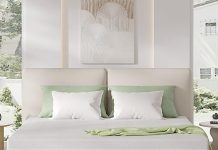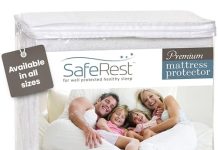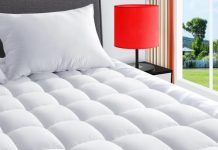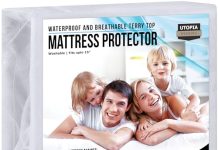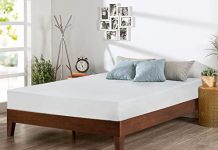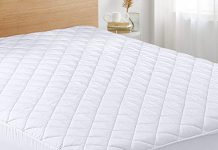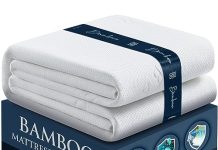Curiosity piqued? Well, let us satisfy your inquisitive minds as we delve into the perplexing world of sleep accessories. Today, we explore the fine line that separates a mattress pad from a topper. So, if you’ve ever pondered about the distinction between these two fluffy accoutrements, buckle up and prepare to have your cozy territory expanded!
This image is property of amerisleep.com.
Review contents
Definition of Mattress Pad
Description
A mattress pad is a quilted or padded material that is placed on top of a mattress to provide an additional layer of protection and comfort. It is usually secured onto the mattress using elastic straps or a fitted sheet. Mattress pads come in various materials and thicknesses, allowing individuals to customize their sleeping experience according to their personal preferences.
Purpose
The main purpose of a mattress pad is to enhance the overall comfort of the sleep surface. It provides a soft and cushioned layer between the body and the mattress, offering additional support and relief to pressure points. Mattress pads also serve as a protective barrier, preventing stains, spills, and general wear and tear from reaching the mattress. This not only helps to prolong the lifespan of the mattress but also keeps it clean and hygienic.
Types of Mattress Pads
Cotton Mattress Pad
Cotton mattress pads are a popular choice due to their natural breathability and softness. They offer a cooling effect, making them ideal for those who tend to sleep hot. Cotton mattress pads are hypoallergenic, making them suitable for individuals with allergies or sensitivities.
Polyester Mattress Pad
Polyester mattress pads are known for their durability and affordability. They provide a plush and cushioned surface, offering a comfortable sleeping experience. Polyester is also resistant to stains and wrinkles, making it easy to clean and maintain.
Wool Mattress Pad
Wool mattress pads are excellent for temperature regulation, making them suitable for both warm and cold climates. They provide natural insulation and moisture-wicking properties, keeping the body cool in the summer and warm in the winter. Wool is also naturally hypoallergenic and resistant to mold, dust mites, and bacteria.
Memory Foam Mattress Pad
Memory foam mattress pads are made from a high-density viscoelastic foam that conforms to the body’s contours, providing personalized support and pressure relief. They are known for their ability to distribute weight evenly, reducing pressure on joints and minimizing motion transfer. Memory foam mattress pads are particularly beneficial for individuals with back or joint pain.
Features of Mattress Pads
Thickness
Mattress pads come in various thickness options, ranging from thin to thick. The thickness of the pad determines the level of cushioning and support it provides. Thicker mattress pads offer a more plush and luxurious feel, while thinner ones provide a subtle layer of comfort without significantly altering the firmness of the mattress.
Quilting Pattern
The quilting pattern of a mattress pad refers to the stitching design on the surface. This not only adds aesthetic appeal but also helps to hold the padding in place and prevent it from shifting or bunching up. Common quilting patterns include diamond, wave, or channel stitching.
Attachment Method
Mattress pads can be attached to the mattress using different methods. Some pads have elastic straps that secure them onto the corners of the mattress, while others have a fitted sheet-like design that hugs the mattress snugly. The attachment method ensures that the pad stays in place throughout the night, providing a seamless and comfortable sleeping surface.
Hypoallergenic Properties
Many mattress pads are hypoallergenic, meaning they are resistant to allergens such as dust mites, mold, and bacteria. This is especially beneficial for individuals with allergies or asthma, as it helps to create a cleaner and healthier sleeping environment. Hypoallergenic mattress pads are typically made from natural materials such as cotton, wool, or bamboo.
Pros of Using a Mattress Pad
Provides Extra Comfort
One of the main advantages of using a mattress pad is the additional comfort it provides. The padded layer adds cushioning and softness to the sleep surface, making it more enjoyable and relaxing. The extra comfort can be particularly beneficial for individuals with a firm mattress or those who suffer from body aches or pressure points.
Protects the Mattress
Another significant advantage of using a mattress pad is the protection it offers to the underlying mattress. The pad acts as a barrier, shielding the mattress from spills, stains, dust, and dirt. This helps to prevent premature wear and tear, extending the lifespan of the mattress and ultimately saving money in the long run.
Easy to Clean and Maintain
Mattress pads are generally easy to clean and maintain. Most pads can be machine washed and dried, making it convenient to keep them fresh and hygienic. Regular cleaning not only removes dirt and stains but also helps to eliminate allergens and odors. The ease of maintenance ensures that the mattress pad remains in good condition and continues to provide optimum comfort.
This image is property of casperblog.imgix.net.
Cons of Using a Mattress Pad
May Alter the Feel of the Mattress
One potential drawback of using a mattress pad is that it may alter the feel of the mattress. Depending on the thickness and material of the pad, it can add an extra layer of softness or firmness to the sleep surface. While this can be desirable for some individuals, it may not suit others who prefer the original feel of the mattress. It is important to choose a mattress pad that complements the existing firmness level of the mattress.
May Retain Heat
Certain types of mattress pads, particularly those made from memory foam or synthetic materials, may have a tendency to retain heat. This can result in the sleep surface feeling warmer, which may be uncomfortable for individuals who are prone to night sweats or prefer a cooler sleeping environment. It is crucial to consider the breathability and temperature-regulating properties of a mattress pad before making a purchase.
Definition of Mattress Topper
Description
A mattress topper is a thick layer of padding that is placed on top of a mattress to enhance its comfort and support. It is typically thicker than a mattress pad and can significantly change the feel of the mattress. Mattress toppers are available in various materials, with each type offering unique benefits and features.
Purpose
The primary purpose of a mattress topper is to improve the overall comfort and support of the sleep surface. It provides an extra layer of padding and cushioning, allowing individuals to customize the firmness and feel of their mattress. Mattress toppers also help to alleviate pressure points, reduce motion transfer, and extend the lifespan of a mattress.
This image is property of cdn.shopify.com.
Types of Mattress Toppers
Memory Foam Mattress Topper
Memory foam mattress toppers are made from a dense and temperature-sensitive foam that conforms to the body’s contours. They offer excellent pressure relief and support by evenly distributing weight and minimizing motion transfer. Memory foam toppers are beneficial for individuals with joint or back pain, as they help to alleviate discomfort and promote spinal alignment.
Latex Mattress Topper
Latex mattress toppers are natural and highly resilient. They provide a responsive and bouncy surface that gently conforms to the body’s shape. Latex toppers offer excellent support and ventilation, promoting airflow and preventing heat buildup. They are hypoallergenic and resistant to dust mites and mold, making them a suitable option for individuals with allergies.
Featherbed Mattress Topper
Featherbed mattress toppers are made from a combination of feathers and down, providing a plush and luxurious sleeping surface. They offer a soft and fluffy feel, adding extra cushioning and comfort. Featherbed toppers are known for their excellent breathability and temperature regulation, keeping the body cool and comfortable throughout the night.
Wool Mattress Topper
Wool mattress toppers provide natural insulation and temperature regulation, making them suitable for all seasons. They offer a soft and cozy surface, helping to relieve pressure points and promote a restful sleep. Wool is naturally hypoallergenic, repellent to dust mites, and resistant to mold and mildew, ensuring a clean and healthy sleeping environment.
Features of Mattress Toppers
Thickness
Mattress toppers come in various thickness options, ranging from medium to extra thick. The thickness of the topper determines the level of support and cushioning it provides. Thicker toppers offer a more plush and sink-in feel, while thinner ones provide a subtle layer of added comfort without significantly changing the firmness of the mattress.
Density/Support
The density of a mattress topper refers to the weight and composition of the foam or material used. Higher-density toppers offer more support and durability, while lower-density ones provide a softer and more lightweight feel. It is important to choose a topper with the appropriate density to ensure it meets individual comfort and support needs.
Temperature Regulation
Some mattress toppers are designed with temperature-regulating properties to enhance sleep comfort. Materials such as latex and wool naturally regulate body temperature by wicking away moisture and promoting airflow. These toppers help to keep the body cool in warm weather and warm in colder conditions, promoting a comfortable and balanced sleep environment.
Motion Isolation
Mattress toppers can also help to reduce motion transfer, allowing for a more undisturbed sleep. Memory foam and latex toppers, in particular, have excellent motion isolation properties. They absorb and isolate movement, preventing disturbances caused by the tossing and turning of a partner or pet. This can be especially beneficial for individuals who are easily awakened by movements during the night.
This image is property of myslumberyard.com.
Pros of Using a Mattress Topper
Enhances Comfort and Support
One of the key benefits of using a mattress topper is the enhanced comfort and support it provides. The added layer of padding and cushioning improves the overall sleeping surface, allowing individuals to achieve a more restful and rejuvenating sleep. Mattress toppers can help to alleviate pressure points, reduce pain, and promote proper spinal alignment for a more comfortable and supportive sleep experience.
Offers Pressure Relief
Mattress toppers, especially those made from memory foam or latex, offer excellent pressure relief. They conform to the body’s curves, evenly distributing weight and reducing pressure on joints and sensitive areas. This can be particularly beneficial for individuals with conditions such as arthritis or fibromyalgia, as it helps to alleviate pain and discomfort, promoting a more restful sleep.
Extends the Lifespan of a Mattress
Using a mattress topper can help to extend the lifespan of a mattress by providing an extra layer of protection. The topper acts as a barrier, shielding the mattress from stains, spills, and general wear and tear. By minimizing direct contact between the body and the mattress, the topper helps to preserve its original condition, thereby increasing its longevity.
Cons of Using a Mattress Topper
Potential Allergies
Some individuals may experience allergies or sensitivities to certain materials used in mattress toppers. For example, feather or down toppers may trigger allergies in individuals who are allergic to feathers or have respiratory conditions. It is important to consider any known allergies or sensitivities before choosing a mattress topper and opt for hypoallergenic options if necessary.
May Require Regular Maintenance
Certain types of mattress toppers, such as featherbed or wool toppers, may require regular maintenance to keep them clean and fresh. Feather toppers may need occasional fluffing to maintain their loft, while wool toppers may need to be aired out and spot cleaned as needed. It is essential to follow the manufacturer’s care instructions to ensure the longevity and performance of the topper.
In conclusion, both mattress pads and toppers serve the purpose of enhancing the comfort and support of a mattress. Mattress pads offer a layer of padding and protection, while mattress toppers provide a thicker layer of cushioning and customization. The choice between the two ultimately depends on individual preferences and specific needs. Whether one opts for a mattress pad or a topper, both options offer a range of features and benefits that can significantly improve the overall sleep experience.
This image is property of assets.wfcdn.com.







